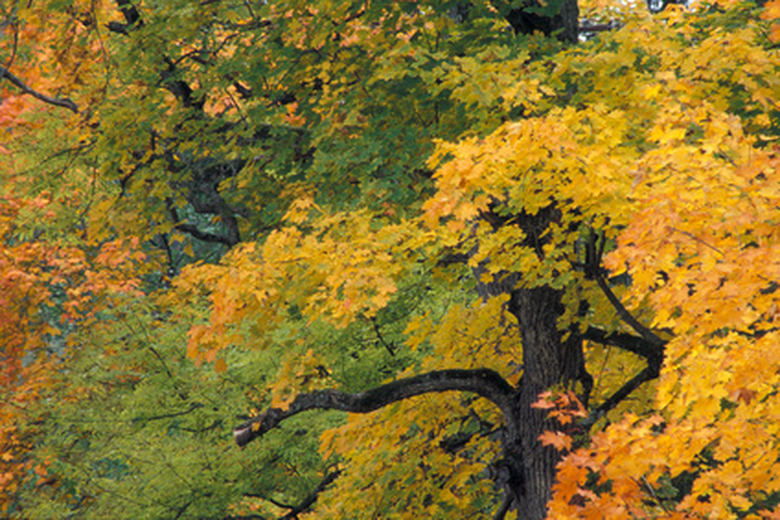10 Deciduous Trees In Michigan
Drive through the Great Lakes state in early autumn, and you will encounter vibrantly painted natural scenery as the deciduous trees prepare for the winter months. The Michigan landscape is comprised of many lakes surrounded by vast areas of woodland. Deciduous trees are those that lose all their leaves as part of the seasonal life cycle, going out in a blaze of glory.
Ash
The ash tree, part of the genus Fraxinus, is a larger relative of olive and lilac trees. Species found throughout Michigan include the blue, black, green and white, all of which provide strong, but pliable wood used to make tool handles, baseball bats, bows and guitar bodies.
Maple
Michigan is home to many maple trees, including red, silver, sugar, black and striped species belonging to the Aceraceae family. Sugar maples are famous for producing maple syrup, and the wood of this species is widely used in the manufacture of bowling pins, pool cues and butcher's blocks. Silver maples are popular because their silvery bark and leaf backs give off a shiny, silver appearance when exposed by the wind.
- Drive through the Great Lakes state in early autumn, and you will encounter vibrantly painted natural scenery as the deciduous trees prepare for the winter months.
- Species found throughout Michigan include the blue, black, green and white, all of which provide strong, but pliable wood used to make tool handles, baseball bats, bows and guitar bodies.
Oak
Several species of the oak tree, famous for its towering strength and longevity, can be found in the Great Lakes state. These grand specimens can grow to more than 100 feet in height and live for centuries. Bur, white, chinkapin, red and black oak trees contribute to the state's third largest industry, timber. Oak, a member of the Fagaceae family, is a favored base for whiskey and wine barrel making, flooring and interior wood flooring and cabinetry.
Dogwood
Dogwoods, genus Cornus, are a deciduous, flowering collection of trees and shrubs. Species such as the gray, red, and silky bloom throughout the spring and summer months, then provide a new burst of color through foliage and branches throughout the fall. Mainly used for landscaping, dogwood trees thrive in boggy areas and along waterfronts, attracting wildlife with brightly colored berries.
- Several species of the oak tree, famous for its towering strength and longevity, can be found in the Great Lakes state.
- Mainly used for landscaping, dogwood trees thrive in boggy areas and along waterfronts, attracting wildlife with brightly colored berries.
Sumac
Michigan's sumac population grows wild and in captivity for ornamental landscaping. Sumacs, member of the Anacardiaceae family, are shrubs and trees that grow from 3 to 30 feet tall. The staghorn species grows large, fan-like leaves with spiked red and purple flowers. Shining sumac sprouts lacy, yellow blooms and foliage that turns vivid shades of red and orange in the fall.
Willow
Willow trees, genus Salix, thrive in the moist, temperate climate of Michigan. The sandbar, black, weeping and peach leaf species of willow trees lend charm and grace throughout the state. The bark of willow trees contain salicin, a compound used to relieve fevers and aches, while the wood is used to make wicker, rope, brooms and other household items.
- Michigan's sumac population grows wild and in captivity for ornamental landscaping.
- Sumacs, member of the Anacardiaceae family, are shrubs and trees that grow from 3 to 30 feet tall.
Eastern Cottonwood
Stately eastern cottonwoods, genus Populus, can grow to more than 100 feet tall and live for several centuries with proper growing conditions. Known as one of the largest North American hardwood trees, the cottonwood is extremely tolerant to flooding and constant soil saturation. Due to its rapid growth rate, cottonwood is commonly grown for timber in wetland and riverbank areas. The wood, which is extremely fibrous, is used to make pallets and shipping crates.
Elm
Michigan's elm tree population includes the American and slippery species. Hailing from the Ulmaceae family, the elm tree dates back more than 40 million years and has long been used in landscaping and as a street tree. Elms can grow in a wide variety of soil conditions as long as there is adequate drainage. The elm's hard, split-resistant wood is used to make wheels, coffins and furniture.
- Stately eastern cottonwoods, genus Populus, can grow to more than 100 feet tall and live for several centuries with proper growing conditions.
- Due to its rapid growth rate, cottonwood is commonly grown for timber in wetland and riverbank areas.
Birch
Birch trees, genus Betula, are smaller trees that range in height from 60 to 80 feet. Paper and yellow species sport delicate branches, shiny, serrated leaves and distinctive bark that peels away from the trunk like paper. The pale, short fibers of birch wood are used in paper and plywood production, while oils extracted from the wood are used in soaps and cosmetics.
Hickory
Michigan is home to the shagmark, bitternut and pignut species of hickory trees, which will grow anywhere there is moist, organically enriched soil. From genus Carya, the hickory tree is comprised of dense, shock-proof wood that is used to make wheels, bows, skis and carts. Hickory chips are used to cure and barbecue meats. Hickory trees live for several centuries, reach heights of 100 feet or more and produce nuts after 40 to 50 years.
- Birch trees, genus Betula, are smaller trees that range in height from 60 to 80 feet.
- From genus Carya, the hickory tree is comprised of dense, shock-proof wood that is used to make wheels, bows, skis and carts.
